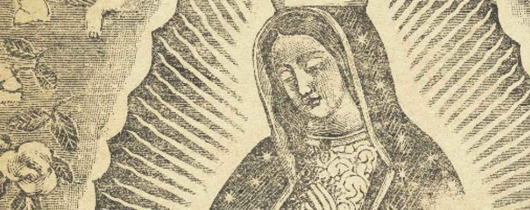Our Lady of Guadalupe | Nuestra Señora de Guadalupe

Revelation 11:19a, 12:1-6a, 10ab; Luke 1:39-47
Throughout history, the first encounters between nations, peoples, and cultures have rarely been marked with everyone holding hands and singing Kumbaya. Human beings are biologically programmed to initially identify their differences and to interpret those differences as potential threats. It takes openness, time, and experience to overcome our biases and fears and to learn to trust and cooperate with each other.
The inherent friction of these first encounters is only intensified when one or both are intent on conquering and plundering the other, and it is made worse by rampant violence and virulent disease. These factors were all present when the Spanish conquistadores came to Mexico and encountered the indigenous people there, just as they were to varying degrees when other people from Europe encountered indigenous people elsewhere in the Americas.
Those who came from Europe often had another motive: to spread the gospel and grow the church. Too often, the zeal for gold outstripped the zeal for God, violating human rights and undermining the gospel message.
Thankfully, as St. Paul said, the word of God is not chained; and the power of the Holy Spirit has always found a way to bring the divine light in the worst darkness. The church has managed to grow and flourish in many different cultures and lands.
Our Lady of Guadalupe, a brown-skinned and pregnant young woman astride the moon and veiled and clothed with the stars, is an icon of the encounter between the European and indigenous peoples. She magnifies God’s power to work in and through all cultures. She is a fitting patron of the Americas, where that story continues to be written. Nuestra Señora de Guadalupe, ruega por nosotros. Jc
--------------------------------------------------------------------------------------------------------------------
12 de diciembre de 2020
Nuestra Señora de Guadalupe
Apocalipsis 11:19a, 12:1-6a, 10ab; Lucas 1:39-47
A lo largo de la historia, los primeros encuentros entre naciones, pueblos y culturas rara vez han sido marcados con todos tomados de la mano y cantando Kumbaya. Los seres humanos están programados biológicamente para identificar inicialmente sus diferencias e interpretar esas diferencias como amenazas potenciales. Se necesita apertura, tiempo y experiencia para superar nuestros prejuicios y miedos y aprender a confiar y cooperar con los demás.
La fricción inherente de estos primeros encuentros sólo se intensifica cuando uno o ambos intentan conquistar y saquear al otro, y se agrava por la violencia desenfrenada y la enfermedad virulenta. Todos estos factores estaban presentes cuando los conquistadores españoles llegaron a México y se encontraron con los indígenas allí, al igual que lo estuvieron en diversos grados cuando otros pueblos de Europa se encontraron con indígenas en otras partes de América.
Los que vinieron de Europa a menudo tenían otro motivo: difundir el evangelio y hacer crecer la iglesia. Con demasiada frecuencia, el celo por el oro superó al celo por Dios, violando los derechos humanos y socavando el mensaje del Evangelio.
Afortunadamente, como dijo San Pablo, la palabra de Dios no está encadenada; y el poder del Espíritu Santo siempre ha encontrado la manera de llevar la luz divina en la peor oscuridad. La Iglesia ha logrado crecer y florecer en muchas culturas y tierras diferentes.
Nuestra Señora de Guadalupe, una joven de piel marrón y embarazada a horcajadas en la luna y velada y vestida con las estrellas, es un icono del encuentro entre los pueblos europeos e indígenas. Ella magnifica el poder de Dios para trabajar en y a través de todas las culturas. Es una patrona adecuada de las Américas, donde esa historia sigue escribiéndose. Nuestra Señora de Guadalupe, ruega por nosotros. jc




